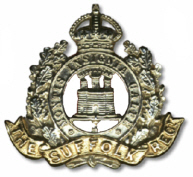



No.16123, Private, Clifford Albert BROWN
Aged 23

|
Albert Clifford BROWN was born in 1895 (Risbridge Q4-1895 4A:697), son of Albert Edward and Emily BROWN (née CLAYDON).
His father was a mat trimmer, following in his father's footsteps, born and raised in Glemsford, and his mother a silk weaver from Haverhill, daughter of John and Maria CLAYDON, both silk weavers living at 18 Union Square, Haverhill. 1901 census...Aged 5, Clifford was at 12 Croft Road, Haverhill with his father Albert BROWN [27] mat trimmer born Glemsford; his mother Emily [29]; sisters Eveleyn [4] and Lily [2] and brother William [4 months]. All except his father were born in Haverhill. 1911 census...Aged 15, a shop assistant, he was still at 12 Croft Road with his parents (mother a hair weaver); sisters Eveleyn (factory hand cloth work0, Emma [7] Gladys [5] and Dorothy [2]; brothers William and John [1 month]. The new siblings all born in Haverhill and all 8 children surviving. A shop assistant in the Co-operative grocery department, Clifford was a regular member of the West End Congregational Church Sunday School. |

|
He enlisted in the 9th Battalion, Suffolk Regiment in Haverhill. Originally the 11th Battalion were men mainly from the Fens, enlisting in Cambridge as
the facilities in Bury St.Edmunds were overwhelmed by volunteer. In a short while they became officially the 11th Battalion, Suffolk Regiment,
but despite there being a Territorial Cambridgeshire Regiment, these Suffolks were often referred to as the "Cambridgeshires" Family memories have him returning from France with appendicitis after 10 months, returning to France in January 1917 The action where he was killed was the attack on the chemical works at Rouex. from Lt Col Murphy's "History of the Suffolk Regiment" and the war diary:- 28th April - 4.25 a.m. Barrage commenced, 4:27 a.m. battalion advanced but was held up and driven back by very considerable hostile machine gun fire from a trench which had been entirely missed by our barrage. What was left of the battalion formed up in our front line. 5:30 a.m. Major Tuck went up to our front line to reorganise our defences. In the front line were 5 officers, 300 other ranks (including 2 officers and 60 other ranks from 16th Royal Scots. 9:45 a.m. The enemy counter attacked from Roeux, capturing MOUNT PLEASANT WOOD and part of CEYLON TRENCH. 10 a.m. All communications with the front line were cut. The enemy driven out of CEYLON TRENCH and MOUNT PLEASANT WOOD. 10 p.m. The battalion moved out of front line trench & support line to enable the heavy artillery to bombard the chemical works. They moved back into the front line at midnight. On this horrific day for the 11th Suffolks, CWGC records 106 killed of which 82 have no known grave. The South West Suffolk Echo reported on 2nd February 1918:- The parents of Private Clifford A.Brown of the Suffolk Regiment, who reside at 12 Croft Road, Haverhill, have received intimation that no further news having been received of their son,who has been missing since 28th April last, the Army Council have been constrained to conclude that he is dead, and that his death took place on 28th April 1917, or since". Pte. Brown, who was 22 years of age, enlisted in October 1914, prior to which he was employed in the grocery department of the Co-operative Stores. After being at the front for ten months he was brought back to England, suffering from appendicitis. Subsequently he again volunteered for service abroad and had been there about three months when he was reported missing"
photo: Rodney Gibson and also in the West End Congregational Church. click here to go to the Commonwealth War Graves Commission website for full cemetery/memorial details |